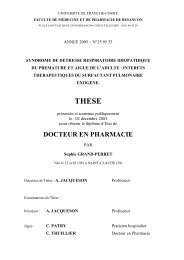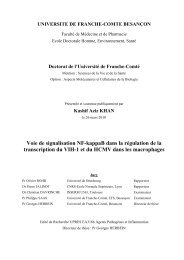THÈSE - Université de Franche-Comté
THÈSE - Université de Franche-Comté
THÈSE - Université de Franche-Comté
Create successful ePaper yourself
Turn your PDF publications into a flip-book with our unique Google optimized e-Paper software.
Figure legends<br />
Fig. 1. Location of the study sites in the Doubs and the Jura <strong>de</strong>partments, France. Circles:<br />
study sites at the low <strong>de</strong>nsity phase and subsequent increase phase; Triangles: study sites at<br />
high <strong>de</strong>nsity phase; Filled triangles: grazing study sites; Open triangles: soil work study sites.<br />
Fig. 2. A. terrestris relative abundance changes against time (2001-2004) recor<strong>de</strong>d in the fortysix<br />
study parcels. For each parcel the analysis of A. terrestris population dynamics takes into<br />
account the data from low <strong>de</strong>nsity (2001) to the maximal value (●). The arrow (↔) represents<br />
the time-lag between the beginning of the A. terrestris increase phase at the parcel scale as<br />
compared to the communal scale.<br />
Fig. 3. Scores of the 13 farming practices variables <strong>de</strong>rived from Principal Component<br />
Analysis (PCA), plotted against the first and the second axes.<br />
Dots indicate the positions of the 46 sampling parcels, ordinated in the space of the first two<br />
principal components (Axes 1 and 2).<br />
Explained variation: axis 1: 31.6%, axis 2: 18.2%. The angles between farming practices<br />
variables in the biplot reflect their correlations, i.e. the smaller the angle the higher the<br />
correlation. The length of the arrow represents the correlation strength between sites (parcels)<br />
and the farming practices variables. Farming practices variables contributing most to the first<br />
axis are in bold and used for interpretation.<br />
Abbreviations: Spgraz, grazing in spring; sumgraz, grazing in summer; autgraz, grazing in<br />
autumn; minen, mineral nitrogen; organ, organic nitrogen; nfertil, nitrogen fertilisation; k,<br />
mineral potassium; p, mineral phosphorus; broma, ro<strong>de</strong>ntici<strong>de</strong>. See Table 1 for more <strong>de</strong>tails.<br />
Fig. 4. Projections of the maximum values (a) and the <strong>de</strong>lay (b) in the canonical space of a<br />
Redundancy Analysis (RDA) between the table of response variables (maximum and <strong>de</strong>lay of<br />
A. terrestris population dynamics) and the table of explanatory variables (organic nitrogen<br />
fertilisation and mowing and T. europaea relative abundance).<br />
Explained variation: axis 1: 18.7%, axis 2: 5.5%. The Monte Carlo permutation test was<br />
significant for the overall regression mo<strong>de</strong>l (P < 0.01).<br />
Thèse C. Morilhat 2005 119









